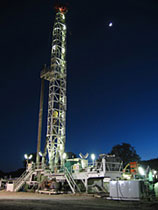 |
| After drilling pilot hole, SAFOD drilled three-mile deep shaft through fault zone. |
At the December meeting of the American Geophysical Union in San Francisco, a team of Stanford University Professors shared the first readings sent to the surface of the earth from a 3-mile-deep hole in the middle of a San Andreas Fault microquake zone.
The Stanford team is working with the U.S. Geological Survey (USGS) to build the San Andreas Fault Observatory at Depth (SAFOD) on a ranch near Parkfield, Calif., halfway between Los Angeles and San Francisco. The SAFOD team drilled a 1.4-mile-deep pilot hole in the summer of 2004. Using data from the seismometers and tiltometer at the bottom of the hole, the scientists determined the best location for a 3-mile shaft that would pierce the heart of the fault.
 |
| Drill Rig |
First, a 185-ft-tall top-drive rotary oil rig drilled a 1.5-mile vertical hole. Then, using a gyroscope, magnetic compass and inclinometer, engineers steered the mechanism at a 54°deviation from vertical for another 1.5 miles to navigate through both plates two miles below the surface. After cementing the hole in August, the SAFOD team began installing seismic monitors and laser strain meters to measure motion, fluid pressure and temperature (which can reach 275° F at this depth).
In 2007, the SAFOD team will take core samples from active areas. These will be sent to rock mechanics specialists from around the country to perform stress-strain analysis to understand the mechanisms of failure under the microscope.
"We want to better understand the physics of the nucleation of earthquakes and how they grow," says Steve Hickman, USGS research scientist. "The first payoff could be finally settling whether earthquake prediction is a realistic societal goal."
Thomas Jordan, professor of geophysics at USC and director of the Southern California Earthquake Center in Los Angeles says the "up close and personal" information geoscientists gather about the complex ways seismic energy - particularly high frequency energy - is radiated might allow seismologists to create models that could better predict ground motion. "Then it is up to engineers to use those models to determine how the energy will propagate to a building and how to design around the motion that can be expected.
"Building codes could ultimately be influenced by the information we learn about probabilistic estimates for certain areas," says Hickman.
SAFOD is one of the initiatives of EarthScope, a five-year, $219-million National Science Foundation program. Deep observatories are being proposed around the world, including one planned for Taiwan.
(Photos courtesy of SAFOD)

Post a comment to this article
Report Abusive Comment